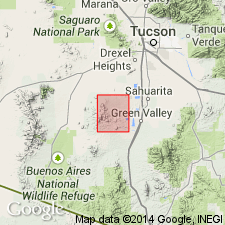
- Usage in publication:
-
- Stevens Mountain Rhyolite*
- Modifications:
-
- Named
- Dominant lithology:
-
- Rhyolite
- Conglomerate
- AAPG geologic province:
-
- Basin-and-Range province
Summary:
Named (named in unpublished thesis). Type locality is on Stevens Mountain in sec 34, T17S, R10E, Pima Co, AZ, Basin-and-Range province. Known exposures are in a belt half a mi wide and about 5 mi long that extends northwest and southeast of type. Consists of a basal conglomerate about 100 ft thick overlain by gray or pink rhyolitic tuffs and flows with lenticular interbeds of quartzite. Basal conglomerate at type is gray to red and has well-rounded pebbles and cobbles of felsic volcanic rock in a tuffaceous matrix. Some interbeds of shale, tuff, felsite, and a capping maroon sandstone in upper part. Ranges from 0 to about 2,000 ft thick. Conformably overlies Tascuela Redbeds (new). Unconformably overlain by the Demetrie Volcanics (new). Correlated with part of Canelo Hills Volcanics. Age is assumed to be Early Jurassic or Late Triassic based on stratigraphic position. Geologic map.
Source: GNU records (USGS DDS-6; Denver GNULEX).
For more information, please contact Nancy Stamm, Geologic Names Committee Secretary.
Asterisk (*) indicates published by U.S. Geological Survey authors.
"No current usage" (†) implies that a name has been abandoned or has fallen into disuse. Former usage and, if known, replacement name given in parentheses ( ).
Slash (/) indicates name conflicts with nomenclatural guidelines (CSN, 1933; ACSN, 1961, 1970; NACSN, 1983, 2005, 2021). May be explained within brackets ([ ]).

